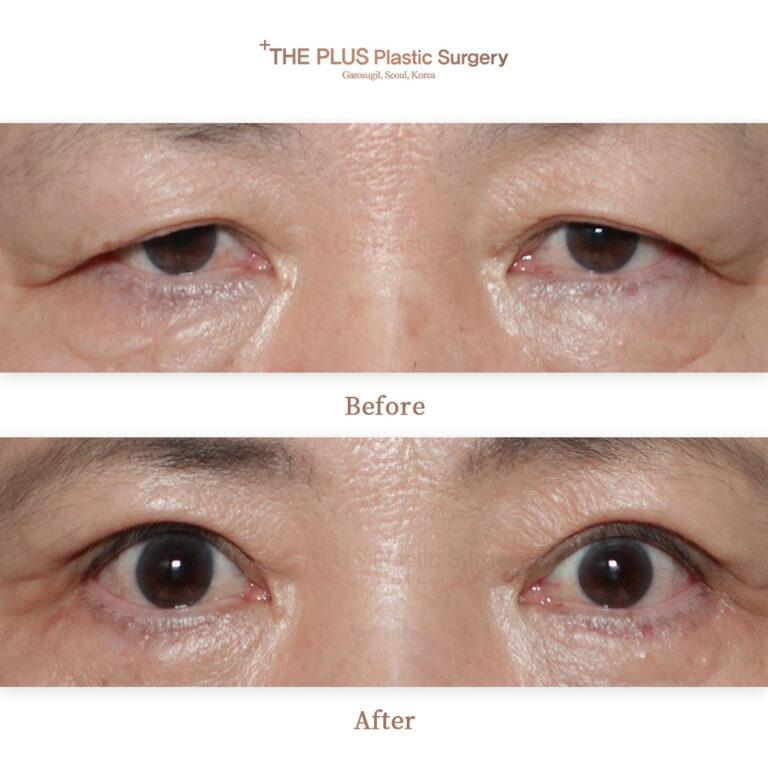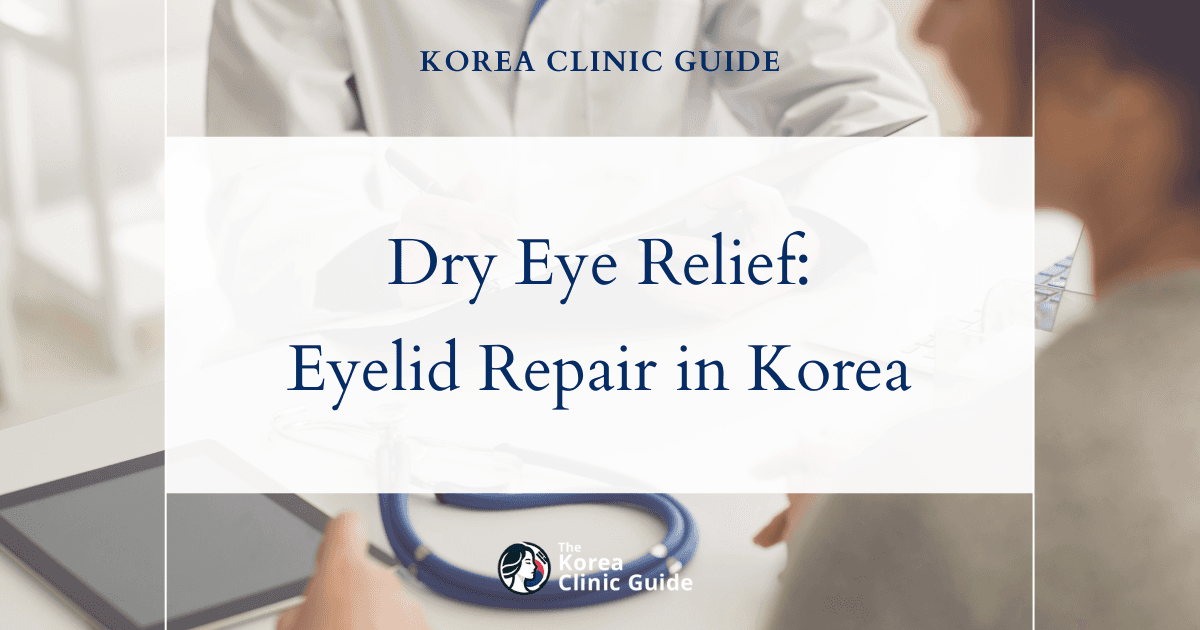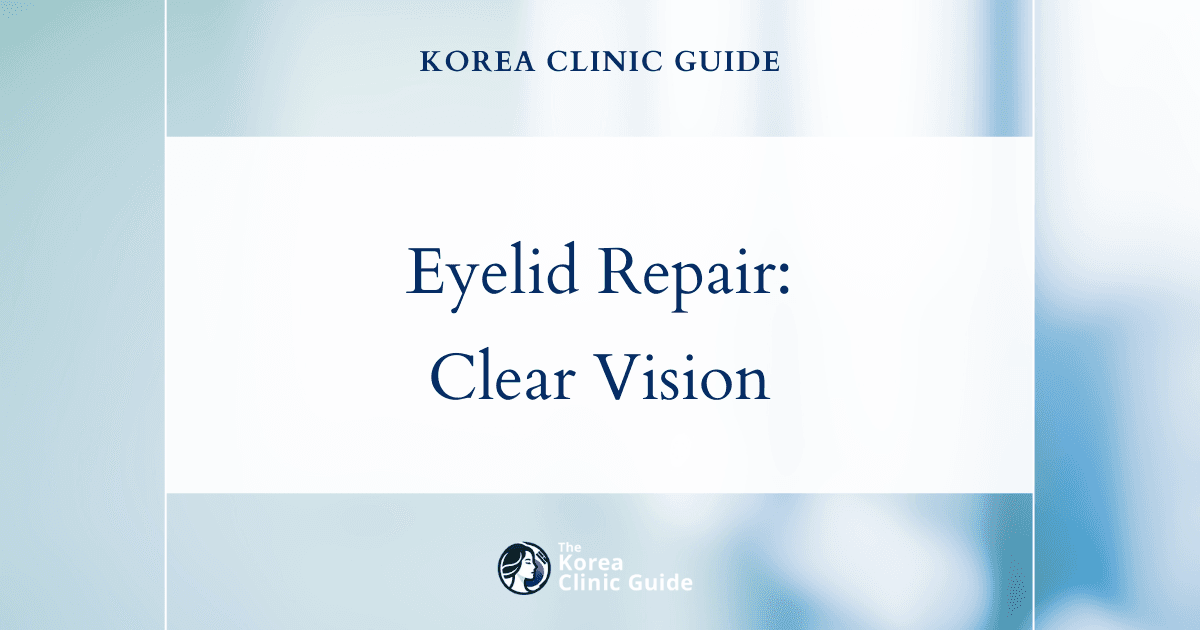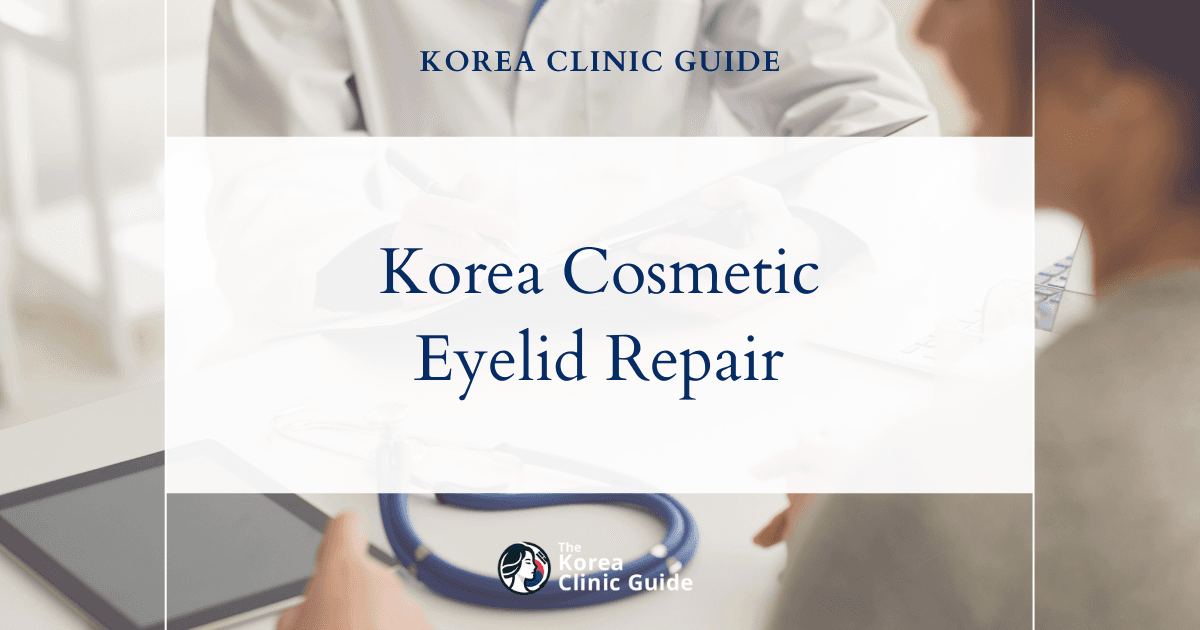Medical Tourism Blog
Correcting Astigmatism and Ptosis in Korea: Top Procedures for Clear Vision

Table of contents
- Understanding Astigmatism: Essential Information
- Ptosis (Droopy Eyelid): Beyond Aesthetic Concerns
- Ptosis Correction Surgery: Restoring Function and Form
- Best Clinics in Korea for Astigmatism
- Medical Tourism in South Korea: A Guide to Ptosis Correction
- Ptosis Correction and Astigmatism: Patient Experiences and Outcomes
- Making an Informed Decision: Next Steps for Patients
- Conclusion
- References
This guide is designed for anyone experiencing blurred vision, especially those exploring "astigmatism" and considering solutions. It explains astigmatism, a common vision imperfection, and discusses "ptosis correction," a procedure that can sometimes improve vision problems caused by drooping eyelids. Additionally, it offers detailed information for those thinking about traveling to South Korea for this surgery, including the process, costs, and patient experiences. The goal is to provide clear, trustworthy information to help readers make informed decisions about their eye health.
Understanding Astigmatism: Essential Information
What is Astigmatism?
Astigmatism is a common, usually treatable imperfection in the eye’s curvature that causes blurred vision at all distances. Normally, the cornea or lens has a perfectly round shape, like a basketball, focusing light sharply on the retina. With astigmatism, the cornea or lens is shaped more like an egg or football, causing light rays to bend unevenly. This creates two overlapping images, resulting in blurred or distorted vision.
Astigmatism falls under "refractive errors," a group that also includes nearsightedness (myopia) and farsightedness (hyperopia). This means the eye’s optical system can’t focus light correctly on the retina. Knowing this helps clarify that astigmatism is about how the eye bends light, not a disease, which is important when considering treatment options.
Common Terms and Related Classifications for Astigmatism
While astigmatism doesn’t have common everyday nicknames, it’s often described by its types or grouped with other vision problems. The two main types are:
- Corneal astigmatism: When the cornea’s shape is irregular. This is the most common form.
- Lenticular astigmatism: When the lens inside the eye has an irregular shape. This is less common.
Astigmatism is broadly classified as a refractive error, alongside myopia and hyperopia.
Signs, Symptoms, and Causes
Signs of astigmatism include blurred or distorted vision, eyestrain, headaches, trouble seeing at night, and frequent squinting.
Children may not realize their vision is blurry or be able to describe it, so early eye screenings by pediatricians or eye care professionals are crucial. Without these, astigmatism can go unnoticed, potentially leading to serious issues like amblyopia (lazy eye). Routine screenings are essential to protect children’s vision development.
Causes and risk factors include:
- Genetics: Often present at birth and inherited.
- Eye Injury: Trauma can change eye shape.
- Keratoconus: A condition where the cornea thins and bulges outward.
- Eye Surgery: Sometimes astigmatism develops after surgery.
Activities like reading in poor light or sitting close to screens do not cause or worsen astigmatism.
How Astigmatism is Diagnosed and Measured
An eye doctor (ophthalmologist or optometrist) diagnoses astigmatism through a comprehensive exam. Astigmatism is measured in diopters (D), with 0 indicating no astigmatism. Most people have 0.5 to 0.75 D. Corrective lenses are usually needed at 1.5 D or higher.
An astigmatism prescription includes:
- Spherical: Indicates nearsightedness (minus) or farsightedness (plus).
- Cylinder: Measures the degree of astigmatism.
- Axis: Shows the location of astigmatism on the cornea (0 to 180 degrees).
Ptosis (Droopy Eyelid): Beyond Aesthetic Concerns
What is Ptosis?
Ptosis is a condition where one or both upper eyelids droop over the eye. The drooping can range from mild to severe and may block peripheral or central vision. Besides affecting sight, ptosis can cause a tired look or facial asymmetry if only one eyelid is affected.
Causes of Ptosis
Ptosis affects both children and adults, with causes including:
- Congenital Ptosis: Present at birth due to levator muscle development issues.
- Acquired Ptosis: Develops later, often from:
- Aging: Skin and muscles weaken over time.
- Trauma or Injury: Damage to eyelid muscles.
- Disease or Neurological Conditions: Affect nerves controlling eyelids.
- Previous Eye Surgery: Surgery can weaken eyelid muscles.
- Long-term Contact Lens Use: Can contribute to eyelid weakening.
Symptoms and Potential Complications
Besides drooping, symptoms may include difficulty keeping eyes open, eye fatigue, headaches from straining, excessive rubbing, tearing, and reduced vision. Children may tilt their heads back or lift their chins to see better, which can cause neck problems and developmental delays.
If untreated, ptosis can lead to:
- Astigmatism: Pressure from the drooping eyelid can change corneal shape, causing or worsening astigmatism, especially the "with-the-rule" (WTR) pattern.
- Amblyopia (Lazy Eye): Refractive errors from ptosis can cause permanent vision loss, especially in children.
- Strabismus: Misaligned eyes may also occur.
Ptosis correction is often medically necessary, not just cosmetic, as it improves vision and eye health.
Ptosis Correction Surgery: Restoring Function and Form

Objectives of Ptosis Correction
The surgery aims to:
- Improve Visual Field: Lift the eyelid to expand peripheral and central vision.
- Enhance Appearance: Create a more youthful, alert look and better facial symmetry.
- Reduce Strain and Headaches: Ease discomfort from lifting eyelids.
- Correct Compensatory Postures: Prevent neck problems from head tilting.
- Support Development in Children: Prevent amblyopia, astigmatism, and strabismus.
Detailed Explanation of Common Surgical Techniques
Ptosis surgery strengthens the eyelid muscle to lift the lid. The method depends on severity and patient needs:
- Levator Muscle Resection or Advancement: Shortening or advancing the levator muscle.
- External Ptosis Surgery (Incisional): Incision on the eyelid’s outside for precise control; leaves a small scar.
- Internal Approach (Non-Incisional): Surgery from inside the eyelid; no visible scar and quicker recovery.
- Frontalis Sling Operation: For severe ptosis with weak levator muscle; connects eyelid to forehead muscle.
- Müller Muscle-Conjunctival Resection (MMCR): Less invasive with faster recovery.
What to Expect During the Procedure
- Outpatient: Most surgeries are same-day procedures.
- Anesthesia: Usually local with sedation; sometimes general anesthesia.
- Duration: About 1 to 2 hours.
- Recovery: Mild swelling and bruising last 1-2 weeks; most resume activities quickly. Eye dryness or irritation is common but manageable.
- Risks: Infection, bleeding, anesthesia reactions, corneal damage, eyelid closure issues, or ptosis recurrence. Initial asymmetry or over/undercorrection may occur but often improves over time. Surgeons discuss risks thoroughly beforehand.
Best Clinics in Korea for Astigmatism
Listed below are the best clinics in Korea for astigmatism:
| Clinic Name | Key Features | Special Techniques |
|---|---|---|
| THEPLUS Plastic Surgery | Leading astigmatism-related cosmetic correction clinic in Korea; world-class surgeons; cutting-edge technology; focus on patient safety and satisfaction; led by Dr. Kim Taek Kyun (pioneer in 3D implants, rhinoplasty, facial contouring); Dr. Jeong Jae Yong (global lecturer, President of the Korean Society of Plastic Surgeons); Dr. Lee (breast surgery specialist); four floors in Garosu-gil; comprehensive care from consultation to post-op; internationally published surgeons; strong academic leadership. | Advanced 3D implant techniques; rhinoplasty; facial contouring; academic integration of form and function in surgical outcomes; personalized cosmetic and reconstructive procedures for astigmatism. |
| Made Young Plastic Surgery | Premium facial and eye surgery clinic in Gangnam; led by Dr. Park Byung-Chan (15+ yrs exclusive eye surgery experience); natural results; direct doctor consultations; focus on customized and attractive eye outcomes; strict safety protocols with certified anesthesiologists; one-to-one monitoring; full CCTV; award-winning (2022 Korea No.1 Award, Customer Satisfaction 1st Place); systematic aftercare center. | Precision double eyelid, ptosis, and anti-aging eye surgery techniques; personalized incision and eyelid planning; advanced safety and monitoring systems for eye procedures (including astigmatism). |
| Okay Plastic Surgery Clinic | Holistic approach to aesthetic and reconstructive procedures; tailored eye surgery; emphasis on sincerity, precision, and personalization; renowned female surgeon; latest medical techniques; broad menu: body contouring, breast augmentation, facial rejuvenation, scar management, and skin care; double eyelid, under-eye, revision surgeries; focus on personal transformation and well-being. | Empathetic guidance in astigmatism-related and eye surgeries; advanced eye, facial, and body procedures; comprehensive individualized aesthetic and functional corrections. |
THEPLUS Plastic Surgery
THEPLUS Plastic Surgery in Gangnam stands out as the leading clinic for astigmatism-related cosmetic correction in Korea, thanks to its combination of world-class surgeons, cutting-edge technology, and unwavering focus on patient safety and satisfaction. The expert team, led by Dr. Kim Taek Kyun—a celebrated board-certified plastic surgeon recognized for his pioneering research in 3D implants and his expertise in rhinoplasty and facial contouring—brings an artistic approach that emphasizes natural, harmonious facial balance. President of the Korean Society of Plastic Surgeons, Dr. Jeong Jae Yong, further elevates the clinic's reputation through his global lectures and panels on integrating form and function, ensuring every intervention optimizes both aesthetic beauty and practical outcomes. Dr. Lee, renowned for her specialization in breast surgery and her tenure at top-tier hospitals, brings a meticulous and client-centered approach to all procedures. THEPLUS Plastic Surgery spans four floors in the vibrant Garosu-gil district, offering comprehensive services from consultation to post-operative care, all under the guidance of internationally esteemed surgeons who regularly publish in medical journals and lead educational forums. This rare blend of academic leadership, innovative surgical techniques, and an ethos grounded in personalized care has propelled THEPLUS Plastic Surgery to the forefront of advanced cosmetic and reconstructive surgery in Korea, making it a top choice for anyone seeking the best results for astigmatism and related procedures.
You can check out their website here: THEPLUS Plastic Surgery Website

Made Young Plastic Surgery
Made Young Plastic Surgery Clinic, located in the heart of Seoul’s renowned Gangnam district, is recognized as a premium destination for facial and anti-aging procedures, with a special focus on delivering outstanding eye surgery results. Dr. Park Byung-Chan, the clinic’s lead surgeon, brings over 15 years of dedicated experience exclusively in eye surgery, further distinguishing the clinic as a leader in the field. Patients choose Made Young for Dr. Park’s ability to achieve natural and beautiful eye results, often evident right on the day of surgery. He employs a genuine, patient-centered approach that guides individuals from the initial consultation to the completion of their surgery, ensuring incision lines, double eyelid height, eyelid thickness, and overall eye shape are customized for the patient’s most harmonious and attractive result.
Beyond technical expertise, Made Young is committed to safety, transparency, and comprehensive care at every step. The clinic’s medical team consists exclusively of doctors with an average of over 15 years of hands-on experience and verified clinical expertise, providing direct consultation and pre-procedure diagnosis. Safety is ensured through the presence of full-time board-certified anesthesiologists, one-to-one dedicated monitoring systems, emergency cross-check protocols, and full CCTV coverage of all procedures. After each procedure, patients benefit from a thorough and systematic aftercare service, supported by a dedicated center. Recognized with multiple awards, including the 2022 Korea No.1 Award and the Korea Customer Satisfaction 1st Place, Made Young Plastic Surgery remains a leading choice in Korea for those seeking advanced and natural-looking eye procedures, including those addressing astigmatism.
You can check out their website here: Made Young Plastic Surgery Website

Okay Plastic Surgery Clinic
Okay Plastic Surgery Clinic in Korea distinguishes itself through a holistic approach to aesthetic and reconstructive procedures, offering a wide spectrum of eye surgery options tailored to each patient’s unique needs. Driven by a philosophy rooted in sincerity, precision, and personalization, the clinic ensures that patients seeking solutions for conditions like astigmatism or other ocular concerns receive individualized care. Their team, which features a renowned female plastic surgeon with extensive expertise, emphasizes empathetic guidance and employs the latest medical techniques to deliver results that not only restore function but also enhance personal confidence.
Beyond treating astigmatism, Okay Plastic Surgery Clinic provides an extensive menu of services ranging from body contouring and breast augmentation to advanced facial rejuvenation, scar management, and specialized skin care. The clinic’s comprehensive approach extends to specialized procedures like double eyelid surgery, under-eye correction, and revision surgeries, making it a one-stop destination for patients seeking both functional eye surgery and aesthetic enhancement in Korea. Each visit is designed as a journey of personal transformation, reflecting the clinic’s commitment to both excellence in outcomes and the overall well-being of every patient.
You can check out their website here: Okay Plastic Surgery Clinic Website

Medical Tourism in South Korea: A Guide to Ptosis Correction
The Process: From Inquiry to Recovery
South Korea is a top destination for medical tourism, known for advanced technology and skilled surgeons, especially for ptosis correction. The process for international patients is well-organized:
| Step | Description | Key Details |
|---|---|---|
| 1. Initial Research & Clinic Selection | Choose a clinic and surgeon specializing in eye surgery. | Clinics in Seoul (Gangnam, Apgujeong) offer multilingual consultations (English, Mandarin, Japanese). Review reputations, before-and-after photos, and credentials. Online consultations are common. |
| 2. Travel & Accommodation Planning | Arrange travel and lodging. | Incheon Airport is main entry. Clinics often provide concierge services for airport pickup, accommodation, and SIM cards. Staying in central Seoul is convenient. |
| 3. Face-to-Face Consultation & Examination | Detailed in-person evaluation to finalize treatment. | Includes physical exams, photos, and imaging (MRI/CT) if needed. Patients discuss goals and risks with surgeons. Korean clinics are known for thorough care. |
| 4. The Surgical Procedure | Ptosis correction surgery performed. | Usually under local anesthesia with sedation; general anesthesia if needed. Surgery lasts 1-2 hours. Advanced techniques aim for natural results and minimal scarring. |
| 5. Postoperative Care & Follow-ups | Instructions and follow-ups to monitor healing. | Swelling and bruising subside in 1-2 weeks. Some clinics offer LED therapy or herbal compresses to speed recovery. |
| 6. Recovery & Exploration | Patients can explore South Korea during recovery. | Light activities like visiting museums, palaces, shopping, and markets are possible. |
| 7. Communication & Support | Multilingual support throughout the process. | Clinics provide translators, coordinators, and concierge services for smooth experience. |
Costs and Value: South Korea vs. Global Options
Estimated Costs for Ptosis Correction in South Korea
The average cost is about ₩2,700,000 KRW (~$2,000 USD), ranging from ₩1,500,000 to ₩4,500,000 KRW ($1,100 to $3,200 USD) depending on the procedure:
- One eye: ₩1,800,000 – ₩2,500,000 KRW ($1,400 – $1,900 USD)
- Both eyes: ₩2,800,000 – ₩4,000,000 KRW ($2,200 – $3,000 USD)
- Combined with double eyelid surgery: ₩3,500,000 – ₩5,000,000 KRW ($2,700 – $3,800 USD)
What's Typically Included in the Cost
Packages often cover:
- Consultation fees and exams
- Surgery and advanced equipment use
- Surgeon’s fees
- Anesthesia and anesthesiologist
- Postoperative care, medications, and tests
- Facility fees for operating room and amenities
- Additional services like coordinators and translators
Factors Influencing the Final Cost
Costs vary by:
- Surgical method (incisional more expensive)
- Clinic reputation and location (Seoul clinics may charge more)
- Procedure complexity and combination with other surgeries
- Surgeon’s experience and renown
- Technology and techniques used
- Revision surgeries
- Promotions or discounts
Cost Comparison: South Korea vs. Other Countries
| Country | Approximate Average Cost (USD) |
|---|---|
| South Korea | $1,100 - $3,200 (average ~$2,000) |
| USA | $3,000 - $5,000+ (average ~$3,000) |
| UK | Starts at $3,100 |
| Australia | Starts at $3,800 |
South Korea offers a strong value with advanced care at lower prices. Its transparent, all-inclusive pricing contrasts with Western countries where extra fees often arise later.
Tips for Managing and Potentially Reducing Costs
- Pay in full upfront for possible discounts (up to 10%)
- Agree to before-and-after photos for promotional use
- Combine procedures for package discounts
- Claim VAT refunds as a foreign visitor by keeping receipts and using airport tax refund machines
Ptosis Correction and Astigmatism: Patient Experiences and Outcomes
How Ptosis Correction Can Improve Astigmatism
Ptosis surgery can improve astigmatism when the drooping eyelid causes corneal distortion. By relieving eyelid pressure, the cornea can return to a more natural shape, reducing astigmatism. However, ptosis correction is not a direct astigmatism treatment like LASIK or toric lenses. It only helps if the eyelid pressure is the cause. If astigmatism arises from other factors, different treatments are needed.
Summary of Clinical Findings and Research
Studies show:
- In 42 eyes studied, 72.2% with preoperative astigmatism ≥1.5 D had reduced astigmatism after surgery, averaging a 0.65 D improvement.
- Most had "with-the-rule" (WTR) astigmatism, with 57.9% showing reduction post-surgery.
- Children with congenital ptosis also showed astigmatism reduction after surgery, regardless of age at intervention, highlighting the importance of early treatment.
- Another study found corneal astigmatism decreased significantly from 1.2 ± 0.3 D to 0.7 ± 0.3 D three months after surgery.
- One study noted an increase in astigmatism post-surgery in children, indicating individual variability.
Overall, most evidence supports that ptosis correction benefits astigmatism when caused by eyelid pressure.
Broader Benefits Reported by Patients and Studies
Patients often experience:
- Improved peripheral and overall vision
- Reduced eye strain and headaches
- A more youthful, alert appearance
- Increased confidence and self-esteem
- Relief from compensatory head postures and neck issues
- Prevention of amblyopia, especially in children
Making an Informed Decision: Next Steps for Patients
Importance of a Comprehensive Eye Examination
If you have blurred vision or suspect astigmatism or ptosis, start with a thorough eye exam by an ophthalmologist or optometrist. This will identify the cause and severity and whether the two conditions are linked.
Consulting with an Ophthalmologist to Discuss Personalized Treatment Plans
After diagnosis, your doctor can recommend the best treatment. If ptosis causes astigmatism, surgery may be advised. The ophthalmologist will explain expected benefits and risks. For astigmatism unrelated to ptosis or remaining after surgery, options include glasses, contacts, LASIK, PRK, or toric lenses.
Key Questions to Ask a Healthcare Provider
Prepare to ask:
- "Is my astigmatism caused by my droopy eyelid?"
- "Which surgical technique suits my condition and why?"
- "What are the risks and benefits of ptosis correction for my vision and appearance?"
- "What is the recovery timeline and post-op care?"
- "How much improvement in astigmatism can I expect?"
- "What options exist for any remaining astigmatism?"
- "Can you share patient testimonials with similar cases?"
- "For medical tourism, what documentation and follow-up care should I plan for?"
Conclusion
Astigmatism and ptosis are common eye conditions that can significantly affect vision and quality of life. Ptosis correction surgery not only improves eyelid function and appearance but can also reduce astigmatism when caused by eyelid pressure. South Korea offers advanced, affordable surgical options with comprehensive support for international patients. A thorough eye exam and consultation with an ophthalmologist are essential first steps to determine the best personalized treatment plan.
References
1, 2, 3, 4, 5, 6, 7, 8, 9, 10, 11, 12, 13, 14, 15, 16, 17, 18, 19, 20, 21















